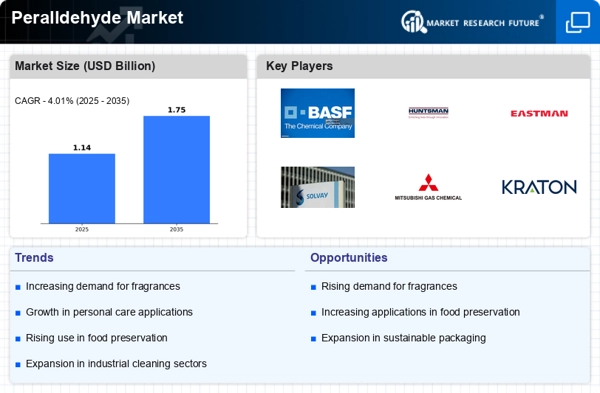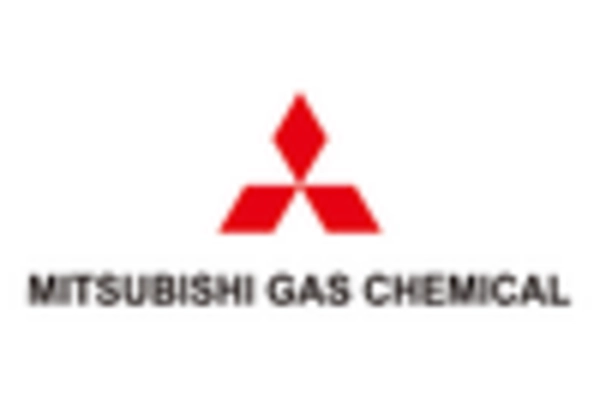Regulatory Support and Compliance
The Peralldehyde Market is benefiting from regulatory support and compliance measures that promote the safe use of chemical substances. Governments and regulatory bodies are increasingly establishing guidelines that encourage the use of effective preservatives in various applications, including healthcare, food, and cosmetics. This regulatory framework not only ensures consumer safety but also fosters innovation within the industry. As companies strive to comply with these regulations, the demand for peralldehyde is expected to rise, as it is recognized for its efficacy and safety profile. Recent reports suggest that compliance with international standards could enhance market opportunities, potentially increasing the market size by 10% over the next few years. Thus, the Peralldehyde Market is likely to thrive in an environment where regulatory support aligns with industry needs.
Rising Demand in Health and Hygiene
The Peralldehyde Market is experiencing a notable surge in demand driven by heightened awareness regarding health and hygiene. This trend is particularly evident in sectors such as healthcare and personal care, where the need for effective disinfectants and preservatives is paramount. The increasing prevalence of infectious diseases has led to a greater emphasis on sanitation, thereby propelling the consumption of peralldehyde as a key ingredient in various formulations. Market data indicates that the health and hygiene segment is projected to witness a compound annual growth rate (CAGR) of approximately 6% over the next five years, underscoring the critical role of peralldehyde in maintaining public health standards. As consumers become more health-conscious, the Peralldehyde Market is likely to expand further, catering to the evolving needs of both manufacturers and end-users.
Technological Advancements in Production
Technological advancements in the production of peralldehyde are significantly influencing the Peralldehyde Market. Innovations in manufacturing processes are leading to enhanced efficiency and reduced production costs, making peralldehyde more accessible to various industries. For instance, the adoption of green chemistry principles is facilitating the development of more sustainable production methods, which are increasingly favored by environmentally conscious consumers. Furthermore, advancements in analytical techniques are enabling better quality control and consistency in peralldehyde products. Market data indicates that the introduction of these technologies could potentially increase production capacity by up to 20% over the next few years. As a result, the Peralldehyde Market is likely to experience a boost in supply, meeting the growing demand across multiple sectors while adhering to sustainability goals.
Expansion in Food and Beverage Applications
The Peralldehyde Market is poised for growth due to its expanding applications in the food and beverage sector. As food safety regulations become increasingly stringent, manufacturers are seeking effective preservatives to enhance product shelf life and maintain quality. Peralldehyde, known for its antimicrobial properties, is gaining traction as a viable solution for food preservation. Recent market analysis suggests that the food and beverage segment is expected to account for a significant share of the overall peralldehyde consumption, with a projected CAGR of around 5% in the coming years. This growth is attributed to the rising demand for processed and packaged foods, which necessitate the use of preservatives to ensure safety and freshness. Consequently, the Peralldehyde Market is likely to benefit from this trend, as it aligns with the increasing focus on food quality and safety.
Growing Awareness of Environmental Sustainability
The Peralldehyde Market is increasingly influenced by the growing awareness of environmental sustainability among consumers and manufacturers alike. As the global focus shifts towards eco-friendly products, there is a rising demand for sustainable alternatives in various applications. Peralldehyde, when produced through sustainable methods, can serve as a greener option compared to traditional preservatives. This shift is prompting manufacturers to invest in research and development aimed at creating more environmentally friendly formulations. Industry expert's indicate that the demand for sustainable products is expected to grow at a CAGR of approximately 7% in the next few years. Consequently, the Peralldehyde Market is likely to adapt to these changing consumer preferences, positioning itself as a leader in sustainable chemical solutions.

















Leave a Comment